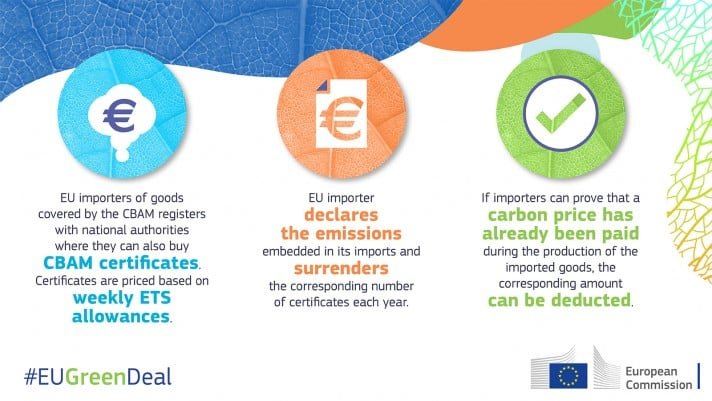Despite significant opposition from some trading partners, the European Commission has enacted the reporting rules for its carbon pricing tool known as the Carbon Border Adjustment Mechanism or CBAM that will take effect during its transitional phase in October 1, 2023.
CBAM, a key pillar of the EU’s Fit for 55 Agenda, is the bloc’s significant tool to prevent carbon leakage. It’s created to ensure that companies operating inside and outside the region remain on the same page in terms of carbon pricing and environmental impact.
Carbon leakage happens when a company operating in the EU move its production abroad where there’s less stringent climate regulations. It also occurs when products made in the region are substituted by more carbon-intensive import goods.
A study estimates that unchecked carbon leakage can result in a 15% increase in global carbon emissions, hurting climate actions. CBAM seeks to avoid this.
Putting a Fair Price on Carbon
As the EU gradually introduces the mechanism, the Implementing Regulations will initially apply to carbon intensive industries and certain goods. These particularly include iron and steel, cement, electricity, hydrogen, aluminum, and fertilizers.
Once CBAM becomes fully phased in, it can address >50% of the emissions of the sectors under the EU ETS. Its transition phase will run until the end of 2025.
The new rules adopted specify the reporting obligations for importers of CBAM covered goods. It also provide details of the methods how to calculate embedded emissions generated in producing those products.
This guidance is published by the EC to also help third country producers of CBAM goods. The Commission will also provide materials, tutorials, and webinars to help affected companies once the transitional phase starts.
First report, which includes 2023 4th Qtr. data (starting October 1), will be due by January 31 next year. Traders only need to submit their report without having to pay for any financial adjustments. This is to give enough time for companies to get used to it while the methods are adjusted by 2026.
By ensuring that a carbon price has been paid for the embedded emissions of the imported goods and that it’s equal to the carbon price of domestic production, the CBAM is putting a fair price on carbon. The mechanism also aligns with the WTO rules.
Phasing-In of CBAM, Phasing-Out of Free Carbon Allowances
The gradual phase in of the mechanism will coincide with the phase-out of the free carbon allowances under the EU ETS to decarbonize the industry.
The EC forecasts that the carbon allowance market can reach €4.5 billion annually by 2030. CBAM will significantly affect international trade and revenues.
Starting from January 1, 2026, the new permanent system will require importers to report annually on the volume of goods brought into the EU in the previous year and their associated emissions.
Subsequently, they will need to surrender the corresponding number of CBAM certificates. The cost of these certificates will be based on the weekly average auction price of EU ETS allowances, measured in €/tonne of CO2.
Before the definitive CBAM system takes effect, there will be a comprehensive review of its performance during the transitional phase. Then there will be an assessment of the product scope, evaluating the possibility of including more goods from sectors already covered by the EU ETS into the CBAM. The report will outline a schedule for their inclusion by 2030.
Ultimately, here are the key things under the CBAM’s transitional phase to keep in mind:
Reporting timetable: beginning in October, businesses must collect data on embedded carbon emissions of their imported goods. Reporting starts in January 2024 and ends in 2025.
Industries covered: carbon-intensive industries and certain downstream products (e.g. bolts). Specific indirect emissions under certain conditions may also be included.
CBAM certificates: certificates must include information on the product’s CO2 footprint, origin, production/processes, and GHG emissions data (including indirect emissions, e.g. energy use).
Meeting the reporting rules of CBAM might be tough for traders initially. But its advantages will outweigh the challenges in the long-term by creating a fairer carbon price.
Last year, the U.S. also introduced its own version of CBAM, the Clean Competition Act. It aims to make domestic companies in the U.S. more competitive in the global market.
Well-designed carbon pricing like the EU CBAM will help industries adopt less carbon-intensive and more environmentally friendly production processes, contributing to a greener global economy. This is critical as the world is curbing planet-warming emissions to address climate change.


